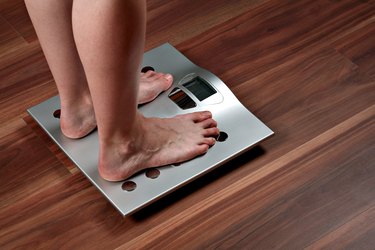
High cholesterol, stroke, heart disease, certain cancers, sleep apnea and hypertension are just some of the conditions you might face when you have overweight. To lose weight, quick fixes such as fad diets might initially provide fast results, but are often hard to maintain and short-lived; any lost weight is quickly gained back. A safer approach is a multifaceted, doctor-approved, weight-reduction program that includes behavior modification, diet and exercise. Instead of just going on a diet, you'll be creating a new, healthy lifestyle for lasting results.
Step 1

Consult your doctor before starting a diet or exercise routine. Unlike losing 5 pounds, losing 75 pounds takes a longer time and might require medical guidance, especially if you already have obesity-related health conditions. A doctor can examine and guide you, and ensure that your planned weight-loss regimen is healthy, safe and right for your physical condition.
Video of the Day
Step 2

Set a realistic goal of losing 1 to 2 pounds per week by creating a daily deficit of 500 to 1,000 calories. Monitor how many calories you consume to sustain your current weight. Then subtract 500 to 1,000 calories from this number to determine how many calories you must consume to lose weight. The deficit that's needed can be achieved by burning calories through exercise and eating fewer calories.
Step 3

Change your diet and eating habits to reduce your caloric intake and promote weight loss. Eat whole grains, veggies, low-fat or non-fat dairy, fruits and lean protein, and limit foods that are high in sugar, cholesterol, trans and saturated fats and salt. Keep a food journal to monitor your eating habits and to catch pitfalls early on. Eat smaller portions and compare nutritional information on food labels so you can replace diet-sabotaging foods with low-calorie, nutritious foods.
Step 4

Lead a more active lifestyle to gradually get used to being physically active. For instance, walk the dog more often, walk or ride a bike to your destinations instead of driving there, play a game of tag or jump rope with the kids, or go window shopping at the mall.
Step 5

Incorporate at least 150 minutes of moderate cardio into a week, as recommended by the Centers for Disease Control and Prevention. Initially exercise for 10 to 15 minutes on three days of the week. Then gradually increase the duration or workout on more days until you reach the expert-recommended amount. Find activities that you enjoy. Consider riding a bike, walking briskly, water aerobics or climbing stairs.
Step 6

Perform a full-body strength training routine on two to three, non-consecutive days of the week so your muscles have enough recovery time in between workouts. Work your upper body on one day, and your lower body the next so your worked muscles always have a rest day. Perform exercises, such as lunges, squats, pushups, overhead presses, bench presses and bent-over rows.
Tip
Consider hiring a certified personal trainer to teach you safe and proper exercise form. A registered dietitian can provide expert guidance for designing an adequate diet for healthy weight loss. Don't skip meals -- this will only serve to slow your metabolism and thwart weight loss efforts.
Be patient. Losing 75 pounds safely will not happen quickly. Be prepared to lose the weight steadily, but gradually over the course of several months.
Warning
Before starting a diet or workout routine, consult your doctor, particularly if you have an injury, have been inactive or have a medical condition.
Video of the Day
- National Heart, Lung, and Blood Institute: What Are the Health Risks of Overweight and Obesity?
- National Heart, Lung, and Blood Institute: How Are Overweight and Obesity Treated?
- UCSF Medical Center: Obesity Treatment
- Centers for Disease Control and Prevention: How Much Physical Activity Do Adults Need?
- Centers for Disease Control and Prevention: Improving Your Eating Habits